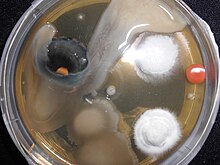 An agar culture of E. coli colonies | |
| Uses | Microbiological culture Art |
|---|---|
| Related items | Petri dish Growth medium |

An agar plate is a Petri dish that contains a growth medium solidified with agar, used to culture microorganisms. Sometimes selective compounds are added to influence growth, such as antibiotics.[1]

Individual microorganisms placed on the plate will grow into individual colonies, each a clone genetically identical to the individual ancestor organism (except for the low, unavoidable rate of mutation). Thus, the plate can be used either to estimate the concentration of organisms in a liquid culture or a suitable dilution of that culture using a colony counter, or to generate genetically pure cultures from a mixed culture of genetically different organisms.
Several methods are available to plate out cells. One technique is known as "streaking". In this technique, a drop of the culture on the end of a thin, sterile loop of wire, sometimes known as an inoculator, is streaked across the surface of the agar leaving organisms behind, a higher number at the beginning of the streak and a lower number at the end. At some point during a successful "streak", the number of organisms deposited will be such that distinct individual colonies will grow in that area which may be removed for further culturing, using another sterile loop.
Another way of plating organisms, next to streaking, on agar plates is the spot analysis. This type of analysis is often used to check the viability of cells and is performed with pinners (often also called froggers). A third technique is using sterile glass beads to plate out cells. In this technique, cells are grown in a liquid culture, in which a small volume is pipetted on the agar plate and then spread out with the beads. Replica plating is another technique used to plate out cells on agar plates. These four techniques are the most common, but others are also possible. It is crucial to work in a sterile manner to prevent contamination on the agar plates.[1] Plating is thus often done in a laminar flow cabinet or on the working bench next to a bunsen burner.[2]
- ^ a b Madigan M, Martinko J, eds. (2005). Brock Biology of Microorganisms (11th ed.). Prentice Hall. ISBN 0-13-144329-1.
- ^ Sanders, Erin R. (11 May 2012). "Aseptic Laboratory Techniques: Plating Methods". Journal of Visualized Experiments (63): e3064. doi:10.3791/3064. PMC 4846335. PMID 22617405. Archived from the original on 14 November 2017. Retrieved 3 May 2018.